What Do Animals Think When We Change Clothes
THE USE OF ANIMALS Inside THE FASHION INDUSTRY by Bárbara Ferreira
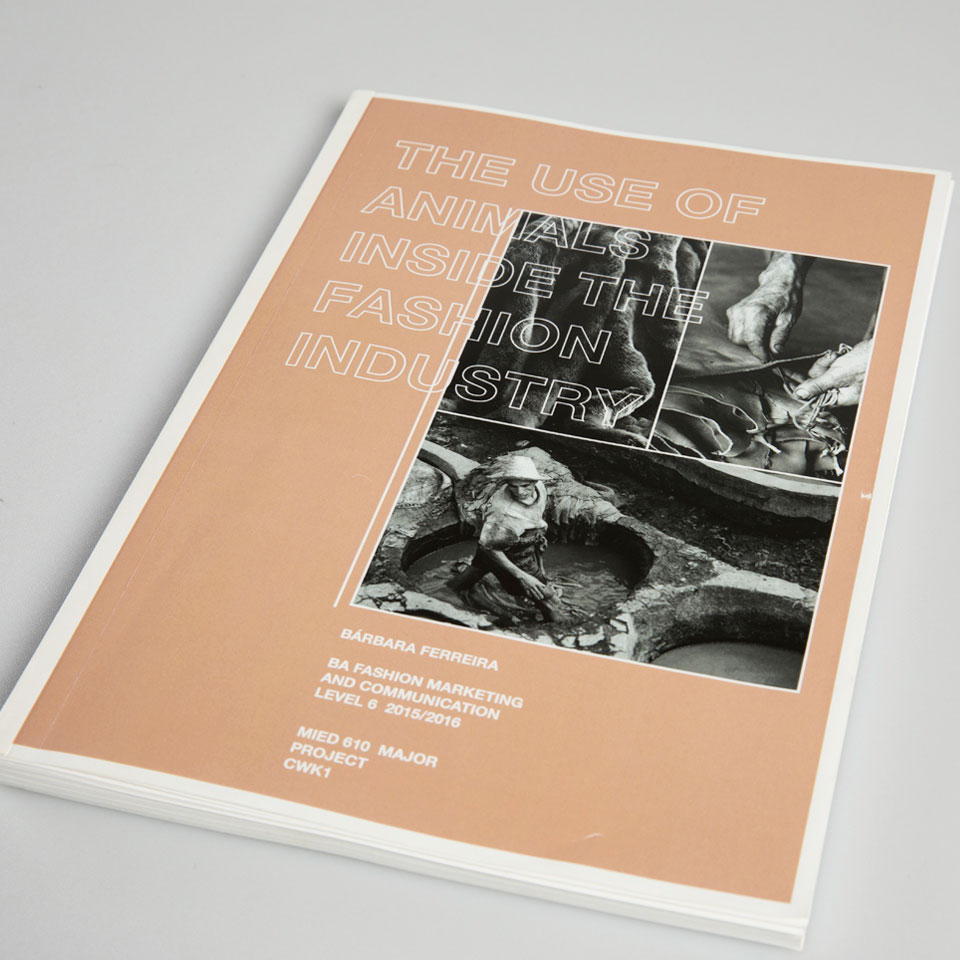
Issue TO ADDRESS
The way industry is ane of the largest in the world and it is at the same time a reflection of society and an amanuensis of socialization capable of influence public stance and standards. Creature materials are vastly used inside the manufacture, but the procedure behind this use and its implications are rarely discussed. Ideals, sustainability, beast well-existence are now gaining presence in our society, which is slowly inlfuencing the fashion manufacture. This topic needs to be explored and analysed, since there is a strong difference betwixt the theories approaching it.
CHALLENGE
This literature review involves the assay and research of different authors regarding the utilize of animals within the manner industry. Past doing so, it aims to fully understand it, determine if it is a problem and how should it exist address. Identify which theories can be a helpful tool for companies and producers that want to follow an ethical and transparent approach towards consumers.
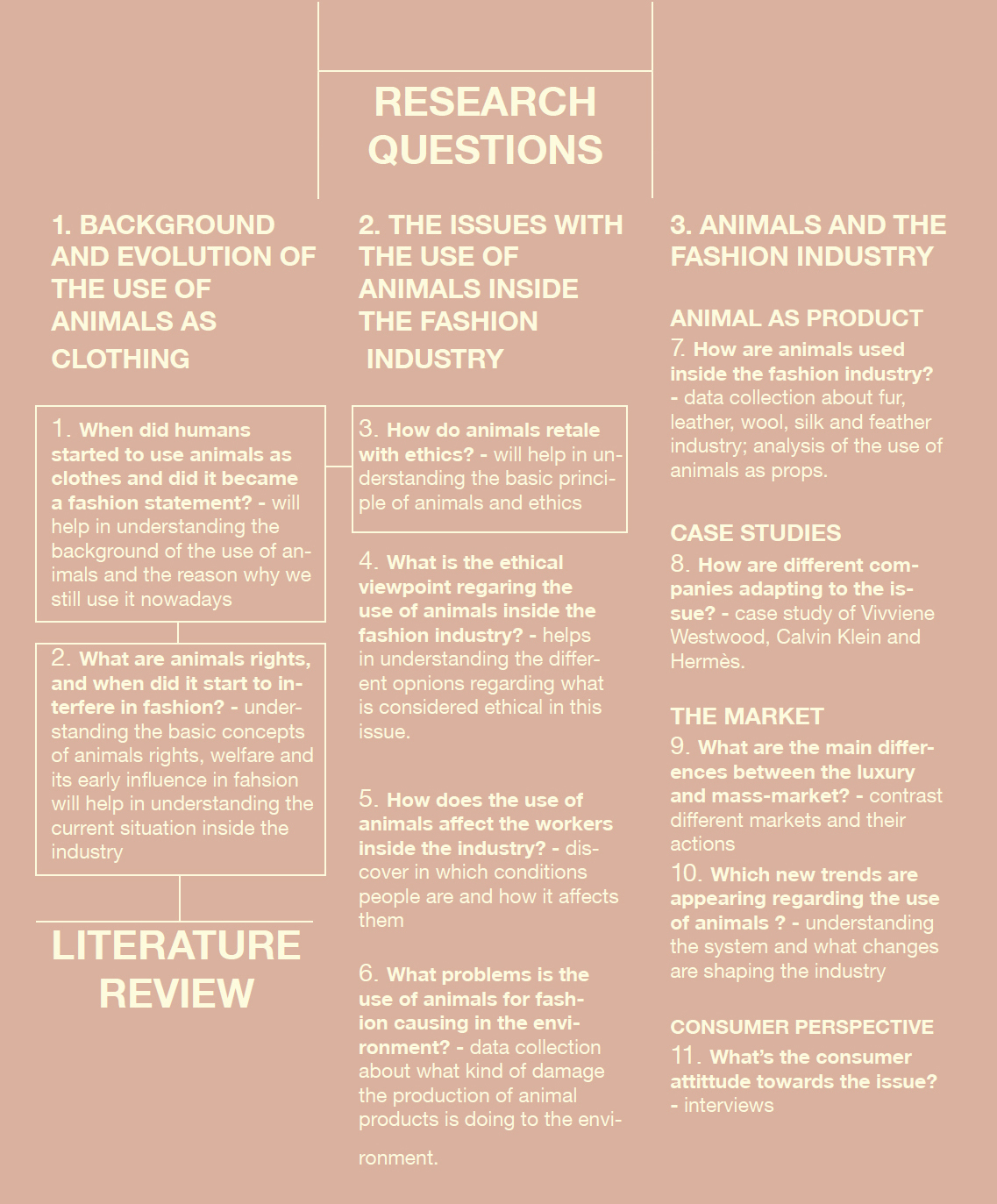
PROJECT
Bárbara Ferreira follows three main strands:
- The historical evolution of the use of animals every bit article of clothing and of the upstanding approaches regarding this utilise.
- The consequences that it entails for subcontract and raw materials workers, for the surround and for the fashion industry itself.
- The manner animals are used past the manufacture, analysing how raw materials are obtained, case studies of how the issue is treated by different companies, the market place dynamics and emerging trends linked to the use of animals and the consumer perspectives gathered through interviews.
SUMMARY
1. Background AND EVOLUTION OF THE Use OF ANIMALS
The literature review analyses five dissimilar authors' publications most the historical beginning of the employ of animals and the main ethical theories regarding to animals:
- Grant, C. (2006). The No-Nonsense Guide to Animal Rights. New Internationalist.
- Owen, M. (2009). Animals Rights: Noble Cause Or Needless Try?. 20-Showtime Century Books.
- Plannthin, D. (2016). Green fashion. 2d ed. Hong Kong: Springer, pp.49 to 123.
- Roleff, T. and Hurley, J. (1999). The rights of animals. San Diego, Calif.: Greenhaven Printing.
- Tortora, P. (2015). Dress, style, and technology. Bloomsbury Publishing.
Barbara Ferreira organises the study of these works around 3 chief questions:
When did humans start to use animals as apparel and when did it become a mode statement?
What are animate being rights and when did they start to interfere with fashion?
How do animals relate to ethics?
This beginning chapter concludes with the compilation of the drawn conclusions. The primary ones are that:
-The beginning grade of fashion is related to accessories made from animals that were intentionally used, not due to necessity.
-Fashion was offset identified during the Middle Ages and was connected to wealth.
-At that place are articulate differences between beast welfare, that allow animate being employ as long equally it don't violate beast welfare, and animal rights, that advocates for the abolitionism of any use.
-Brute rights started to interfere in fashion during the late 70'southward.
-There are 3 main theories regarding animal ethics (descriptions from S. Muthu & 1000. Gardetti, Green way vol. 2):
UTILITARIANISM. (Bentham 1748-1832) "Critical with the utilize of animals just, in exercise, allows anything as long every bit welfare is maximised and does not care about the individual but see them every bit containers for welfare".
Right Ideals. "Rejects all use of animals because it violates their rights non to ebe used as mere ways and rather to have their freedom".
VIRTUE ETHICS.(eudamonia): "Points out that humans have the responsability to give animals the oppotunity to alive a skilful life and that this can be seen equally an expression of the virtues that also help to ensure man a thriving life".
two. THE ISSUES WITH THE Use OF ANIMALS Within THE Mode INDUSTRY

four. WHAT IS THE ETHICAL VIEWPOINT REGARDING THE Utilize OF ANIMALS Within THE FASHION Industry?
She continues studying the unlike upstanding viewpoints regarding the use of animals held by the actors inside the way industry. Designers, journalists and activists' positions are clasified into utilitarianism, right ethics and virtue ideals. An example of each one:
UTILITARIANISM. "In that location is no more than honest barometer of public stance than the cash register. And, every bit fur sales continue to rise and more and more designers integrate fur into their collections the trends are articulate." (Keith Kaplan, The Business of Mode, 2015)
RIGHT Ideals."Through our sustainability, humanitarian and philanthropic actions, we would like Gucci to not just be synonymous with Fabricated in Italy, but also made with integrity (…) the precise history of the chain of supply, from the birth of the moo-cow to the beautiful final product."(Gucci Grouping, about eco-ethical bags)
VIRTUE ETHICS."Isn't the twelvemonth 2015 an odd time for fur to exist such a major trend? Aren't we a bit as well enlightened? Fur production ofttimes involves animal cruelty, non to mention environmentally harmful processes. Its growing presence in the luxury market just doesn't jibe with our era'southward emphasis on social and ecological consciousness." (David Dietz, founder of Modavanti, 2015)
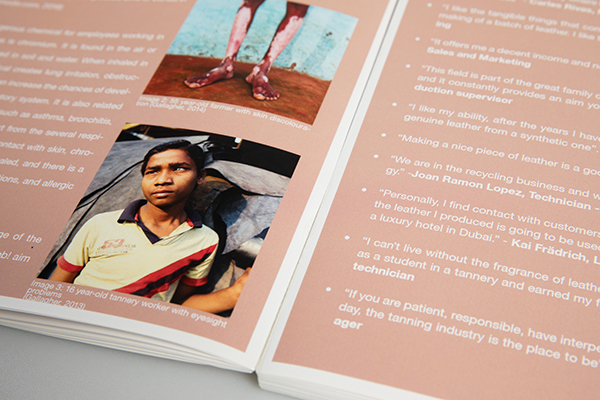
5. HOW DOES THE Utilise OF ANIMALS FOR Fashion AFFECTS WORKERS?
This affiliate puts the focus on something that, despite its importance, has been poorly explored, the effect of the apply of animals on the life of the workers.
What are the psychological consequences of existence obliged to deal with the killing of animals on a daily ground?
The thesis refers here to an interview washed to an exemployee of a Spanish mink farm past Animal Equality. He claims that workers demand to adjust to the process until it becomes bearable. He explains that the brutality of workers towards animals, including situations where the animals are skinned alive (…) tin can be justified by the use of drugs during working hours. Co-ordinate to the source, in case of diseases, employees would kill the animals by placing them alive in plastic numberless, and no medical care was ever provided.
The review goes on to quote the results of an undercover investigation conducted past PETA to American and Australian wool producers that revealed a similar situation of fauna abuse and too identified the psycological state of employees as the core of the problem. PETA recently created a campaign to encourage farmers to conduct drug tests to their employees to improve animal and homo life weather condition.
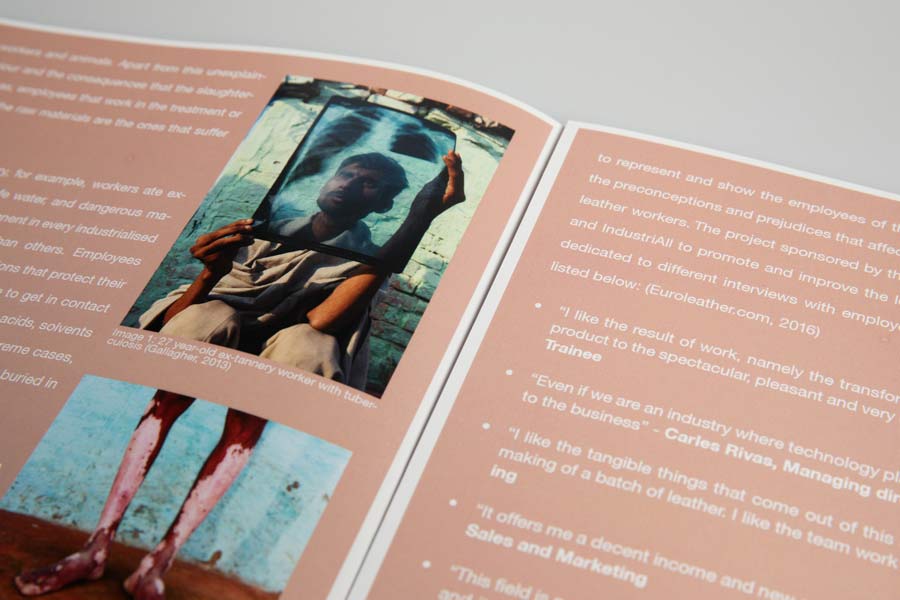

What are the physical consequences of working with beast materials ?
Inside the leather industry, for instance, workers are exposed to toxic gases, unsafe water, and dangerous machinery.
Employees from tanneries lack laws and regulations to protect their rights and interests, and most are liable to make it contact with chemicals such every bit lime, tanning liquor, acids, solvents or chromium that, when inhaled, create lung irritation, obstacle in the airways and can increase the chances of developing cancer, asthma, bronchitis or pharyngitis, among others. When in contact with skin, chromium tin can cause erosive ulceration and allergic dermatitis.
6. WHAT PROBLEMS IS THE USE OF ANIMALS CAUSING IN THE Surroundings?
This chapter starts pointing out a premise held by the authors of Green Fashion, Xenya Cherny-Scanlon and Kristin Agnes: the fashion industry is one of the least regulated and unsustainable industries and although the growing social conscience and demand of transparency, no new regulations have been developed to control certain brands, which has led to an abuse, overuse and mistreat of resources. Two main questions arise from this premise:

Is fashion suffering from the consequences of its own mistakes? The production of fashion products with beast materials is oft associated with the over breeding of a certain animal, organic and toxic waste product and farthermost use of resources. The role style plays in environmental bug limits its capacity to evolve.
Are humans able to risk the planet for fashion products? Consumers need to become conscious of the pollution fashion manufacture is causing in order to brand wiser decisions in the future. Non giving the full spectrum to consumers inhibits alter and puts in adventure the life of thousands of people and time to come generations.
Companies, organisations and researchers have non been providing the nearly authentic information for consumers, which increase misinformation regarding how damaging certain products really are. These corporations want the discipline to be so private, that their actions give the idea of premeditated actions designed to cover malpractices.
From that starting point, the chapter goes through specific data nearly what and to what extend environmental devastation is done past the mode industry.

LACK OF Infinite
Due to the overconsumption of products derived from livestock and the increased growth of homo population, industries have been struggling with the lack of land to abound, feed and kill these animals. This makes animals to be bars in deplorable atmospheric condition and limits change towards a more ethical treatment. The fashion industry uses sure exotic endangered species every bit well, which corrupts ecosystems.
"Livestock product uses one-tertiary of the earth'south fresh water and the 30% of world's water ice-gratis surface, the developing globe accounts the 75% of the global emissions from cattle and other ruminants and the 56% of the global emissions from poultry and pigs" (Walsh, 2016).
DESERTIFICATION
Ane the most important environmental problems. It is divers by "the persistent degradation of dryland ecosystems past human activities". This includes farming, mining, overgraze -"Too many animals in a specific space for likewise long and during wrong seasons", people.oregonstate.edu, 2016-, and clear-cut of land -when copse are uniformly cutting down-.
The Un predicts that at least 50 one thousand thousand people may be displaced during the following ten years due to desertification. It too suggests that through reforestation, water direction and soil treatment, the upshot could be resolved. (Un.org, 2016).
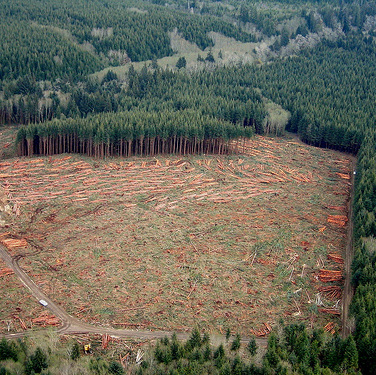
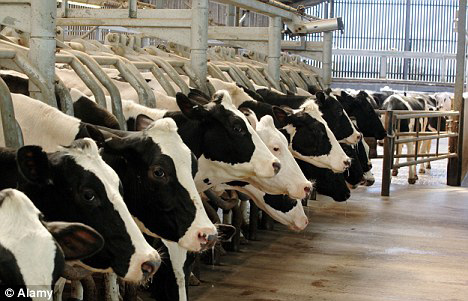
Animal RESIDUES
Factory farming releases over 400 different toxic gases. Sustainable Table states that the primary ones are hydrogen sulphide, methane-ammonia and carbon dioxide, which are related to global warming and health issues (NRDC, 2016).
"Illegal discharge of waste in clean water and soil also increases the adventure for humans and animals. Nitric oxides are released in big quantities from farms and are amidst the leading causes of acid pelting. The gases in livestock facilities tin also pose other risks to workers; marsh gas, for example, is highly flammable." (GRACE, 2016).
Non RENTABLE/SUSTAINABLE SPECIES
The fashion industry likewise has been facing certain problems when it comes to the command of species. For instance, goats are one of the to the lowest degree rentable animals due to their tendency to graze the soil and damage crops with their paws. Certain animals do non provide the results in the short fourth dimension that the industry expects, leading to unethical practices such as mulesing.
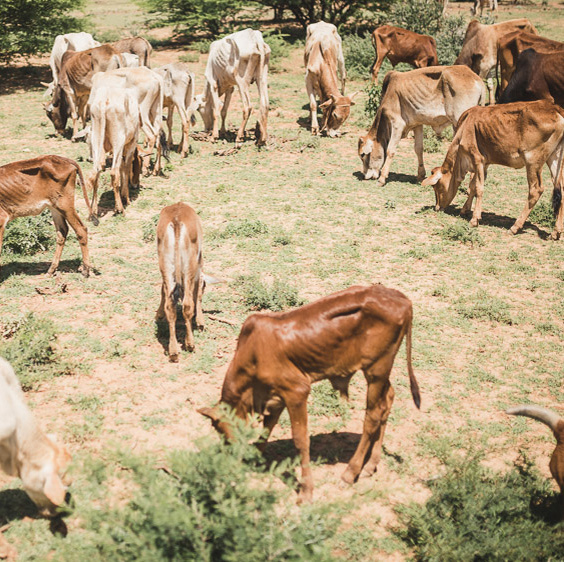

TANNERIES
I of the almost polluting facilities owned by the way industry. Leather, fur and feathers are treated with chemicals such as lime paste, chrome or acids. The majority of mode brands accept airtight many European, Japanese and American tanneries and run this process in countries where labour is cheaper, which led to the opening of unregulated tanneries that contaminate the water and soil of these regions. (Plannthin, 2016).
"A large portion of the world's tanning industry operates in low- and middle-income countries. Many of them are clustered together, creating heavily polluting industrial areas in many countries. In Hazaribagh, for example—a region of Bangladesh that has over 200 tanneries—it is estimated that 7.7 meg litres of wastewater and 88 million tons of solid waste are disposed of on annually. (…) Southern asia, and in particular Republic of india and Pakistan, has the highest number of tanning industries, with South America also at risk of large populations being exposed to chromium contamination." (Worst Polluted, 2011)
So, being a biodegradable and renewable resource is non sufficient to merits that fur is eco-friendly, since, against imitation fur, real one requires a toxic dyeing process, much more free energy and produces enormous quantities of animate being waste. Withal, information technology can be more than sustainable than faux fur. Made from petroleum-based materials, the cruelty-gratis version of fur is unsustainable, since it requires gallons of petrol for a small quantity of product, is not biodegradable or durable, and requires a number of unsafe and toxic chemicals. (McCutcheon, 2013)
Another material that has been considered sustainable is wool, but its overuse of resources is already conditioning its own and other industries' growth. A typical scouring facility can consume up to half million litres of water per twenty-four hour period. (Beven, 1999). This water becomes highly polluted with chemicals and is disposed of in the environment. (O ECOTEXTILES, 2009)
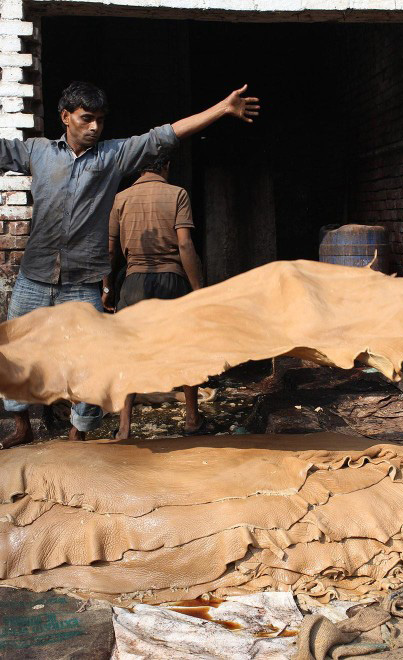
2. THE Problems WITH THE Utilize OF ANIMALS Within THE FASHION INDUSTRY
The tertiary role of the thesis investigates the relationship between the animals and the fashion industry, how are they used, treated and showed past the unlike actors of the fashion industry? This effect is ordinarily not a discussed subject field and most consumers are unversed of the process behind their clothes and accessories.
7. Brute As PRODUCT
The first chapter of this function explores the dissimilar materials -leather, fur, wool, feathers and silk- that animals can go and the means they are used inside the manufacture, including beingness used as props in photo shoots and films.
FUR
-The almost common animals used are foxes, rabbits, minks, chinchillas and otters.
-About of the fur is obtained through farming. We Are Fur, defended to the promovement of the industry, claims that although countries have different laws, international regulations prohibit animal cruelty and ensure minimal intendance such as "muzzle size and enrichment" and "a personalised humane slaughter". Co-ordinate to this source, fur-farming "provides an efficient utilise of animal by-products" since it feeds the animals with food inadequate for man consumption and after slaughter the animals can be used for other farming industries, biofuel or oil, and cosmetics. (WeAreFur, 2016)
–Europe holds 58% of the fur farming around the world.
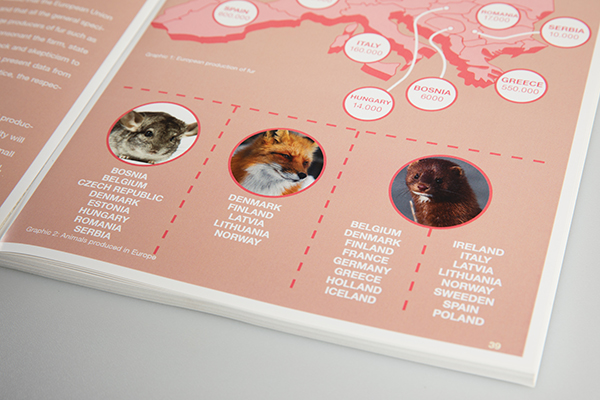
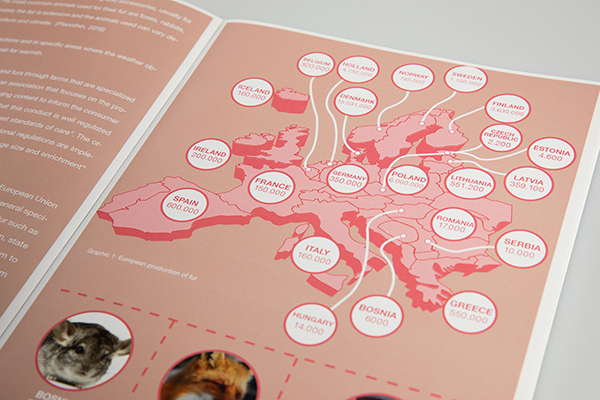
-The big volume of production reflects the different needs of the industry. Depending on the fauna used, a dissimilar quantity of animals will be required.
-The fur industry sales take increased significantly in a short menstruation of time.
-The legal methods used in the slaughter of these animals are gassing with carbon monoxide and anal electrocution, causing painful cardiac arrest without the animal being fully unconscious. (Humane Society International, 2011)
-Well-nigh of the wildlife hunted for their fur do not die immediately from the traps or hunting methods and become seriously injured, some try to escape by amputating a limb. Hunters also propose shooting animals in the face up or gut not to damage the fur, which create extreme pain if it doesn't impale immediately. The steel-jaw trap is banned in some countries, but is nonetheless a favourite method in Canada, USA and Russia. (Plannthin, 2016)
LEATHER
-Leather is the most important and used animal skin.
-The leather industry relies on animals such as calf, buffalo, hides, sheep, deer and kangaroo.
-Some exotic and endangered species –mainly snakes, lizards, crocodiles and elephants- well-nigh went extinct due to the high need for their hide. The list of animals utilise by the leather manufacture also includes frogs, sharks, dolphins, camels, mules, cats and birds. (Plannthin, 2016)
-The manufacture global trade value is approximately 100 billion U.S. dollars per yr. (UNIDO, 2010)
-A large number of consumers from adult countries owns at least i air-conditioningcessory fabricated of leather. (Plannthin, 2016)
-Hides are portrayed as a luxury material, being more expensive than products fabricated of constructed materials.
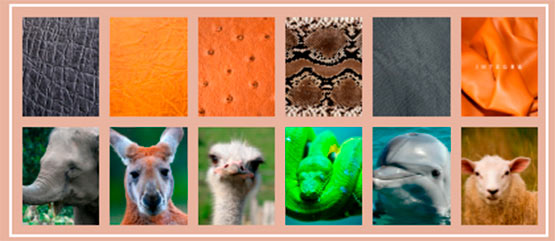
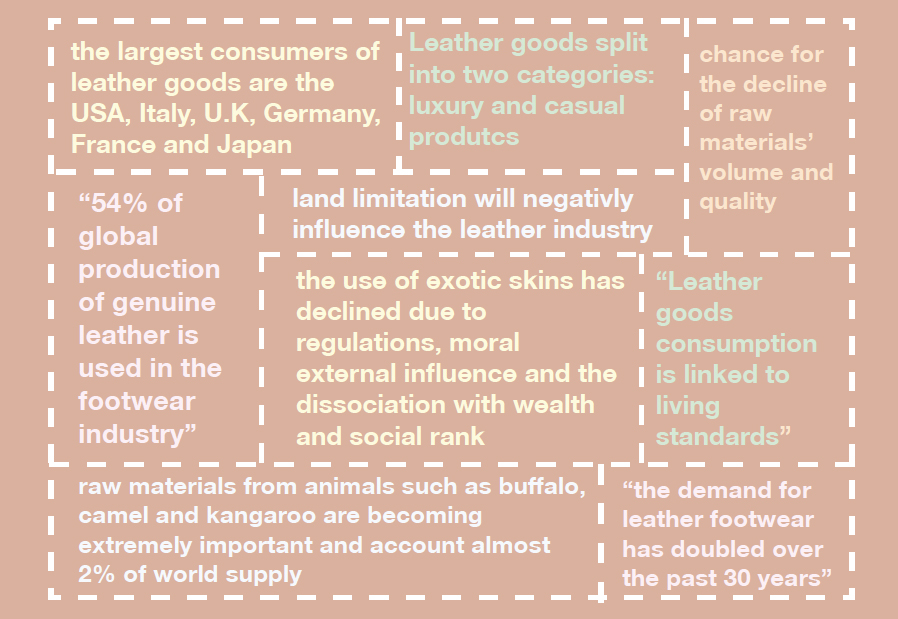
-The meat and dairy industriesouthward are the fuel of leather, providing for over 95% of its raw materials. The consumption of meat and dairy is increasing due to the growth of the population. More population means that more infinite is required for people to live. These people also have other basic needs that rely generally on products of animal origin. To abound these products, sufficient land is needed to inhabit the animals and grow nutrient for them. So, this growth both promotes and threatens meat and leather industries, since almost areas around the earth have already been exploited. (UNIDO, 2010)
-The number of chemical processes that raw leather has to get through makes the cloth to lose all of its "sustainable" natural and organic properties.
FEATHERS
-Has always been used by several cultures equally a personal adornment, and until today does not hold any relevant part besides decoration and warmth.
-Animals such as ostrich, peacocks, doves, geese and turkeys are some of the few species that have been involved in the feathers trade.
-During the late 19th century and commencement of 20th century, feathers were one of the biggest trends among women. The need of the material led to the creation of farms, where birds were bread and plucked alive.
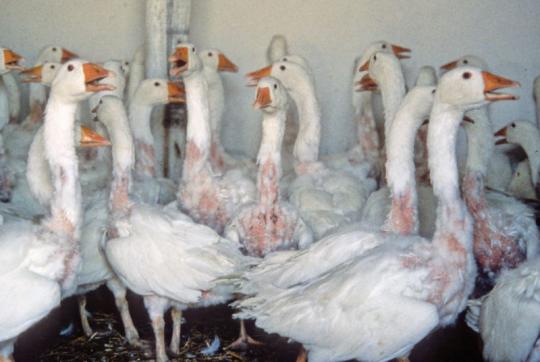
-Unfortunately, nowadays a percentage of the world'due south supply derives from birds plucked alive. The plucking of feathers is painful and dissentious for the creature. The animals go through this procedure every six weeks. The brutality in which these feathers are plucked can lead to serious wounds that are ordinarily taken care off without anaesthesia and dirty materials.
–Synthetic feathers and feathers derived from a by-product of the poultry are considered upstanding and more acceptable and are used in the lifestyle and style industries, simply, although new measures are being implemented, the the of lack of regulation, vigilance, record and proper labelling makes it impossible for the consumer to decide the origin of the feathers. (Plannthin, 2016)
-Another considerable issue that the industry needs to address is the illegal trade of feathers from endangered species. Strict measures and laws are practical regarding more than 1000 species, which helps companies to choose the most appropriate ones.
WOOL
-Wool fibre product involves shaving, washing and yarning of the fibre.
-Wool is known for its qualities such every bit moisture assimilation, warmth, water resistance and durability. Whatever human being-made fibre created and then far has been unable to be as beneficial as wool. (Plannthin, 2016)
–There is not a global organization that tries to regulate and control the unlike processes and conducts. Animal rights organisations have pressured the industry to accost the main problems and create parameters for what it is ecological wool. (Plannthin, 2016)
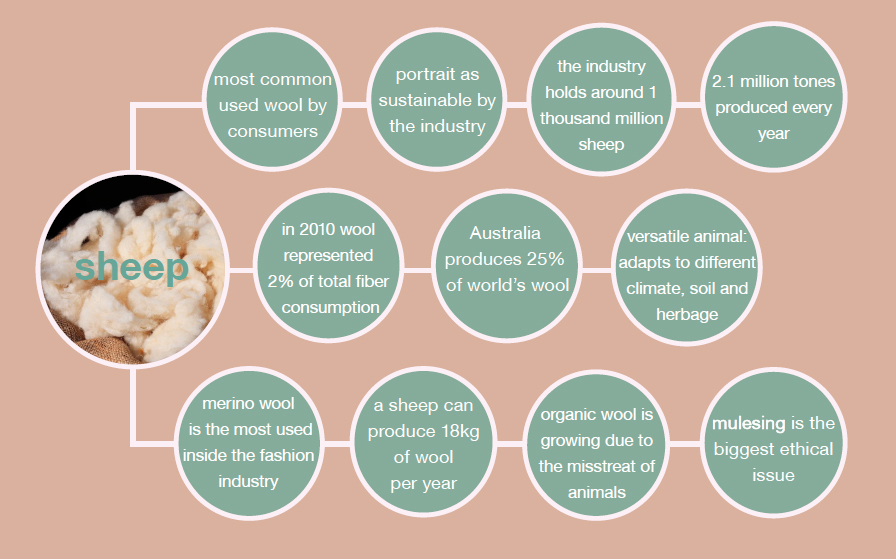
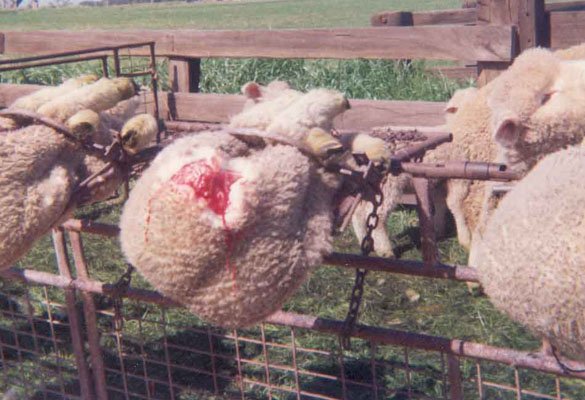
-1 of the biggest issues that animal right activists address is mulesing ("the cutting of flaps of skin from the breech and tail of the lamb with a scalping to create an expanse of blank and stretched skin"), a painful method used to forbid infections that is carried out without anesthesia. Selective breeding and modification to overproduce make the animal unable to shed its fleece, which can provoke death from heat exhaustion, and make them completely dependent on humans, which leads to mulesing. (Plannthin, 2016)
-When compared to leather and fur industries, wool is considered more ethical, since it does not involve killing. Although this makes the practice of extracting wool ethical, non all companies employ wool that derives from farms where animals are treated correctly.
-The demand for organic wool is rising, but, apart from the possible mistreat of animals, the main question that arises in this situation is if there is an bodily demand for so much wool since a large number of humans doesn't live in so low temperatures. (Plannthin, 2016)
SILK
-Although silk doesn't usually come to somebody's mind when thinking about animal materials, it has a great importance in costume and style history, existence kickoff produced in China during the Neolithic flow, within the Yangshao culture.
-Autonomously from the well-nigh known species, the Bombyx Mori, other animals such equally spiders also produce silk. Silk from spiders is used in telescopes, weapons, and optical instruments. (Texeresilk.com, 2016)
-Sericulture consists of the mix of ancient and modern techniques that are dependent on the metamorphosis of these insects.

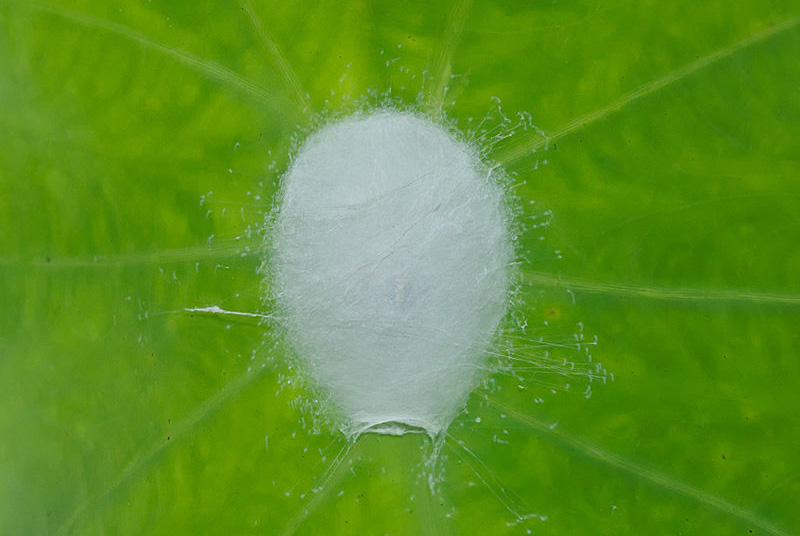
-Due to the extensive breeding of Bombyx Mori, it is believed that the moth is not able to survive in the wild since it has lost its power to fly.
-The techniques used consist on placing the cocoons in hot air, steam or boiling water in society for the silkworm to die without dissentious the silk thread. After that, the thread goes through a serial of processes to obtain the cloth known as silk. (Texeresilk.com, 2016)
-Each cocoon produces very small amounts of raw silk, and the industry requires at least 2500 silkworms to produce approximately 500 grams of silk. (Plannthin, 2016)
ANIMALS IN Advert
-The use of animals every bit props is probably the topic with less awareness but it has a huge touch on, since it employs animals to hide the animal cruelty behind the and focus on what is attractive and pleasant for consumers' conscience, which turns these commercials into an exercise of hypocrisy and lack of transparency.
-When researching the topic, the sources available are very limited, only a few articles and some contained petitions against magazines can be found.
-Christina M. Russo explores the subject in an commodity entitled Why are and then many animals in manner ads? In which she writes that humans take a natural attraction for anything unusual, prohibited and dangerous, and sure animals fall into these categories.
-Joshua Katcher, the editor of the ethical blog The Discerning Creature, explains for the article that this use is not only artful, but designed to trigger emotions in consumers. (Russo, 2014)
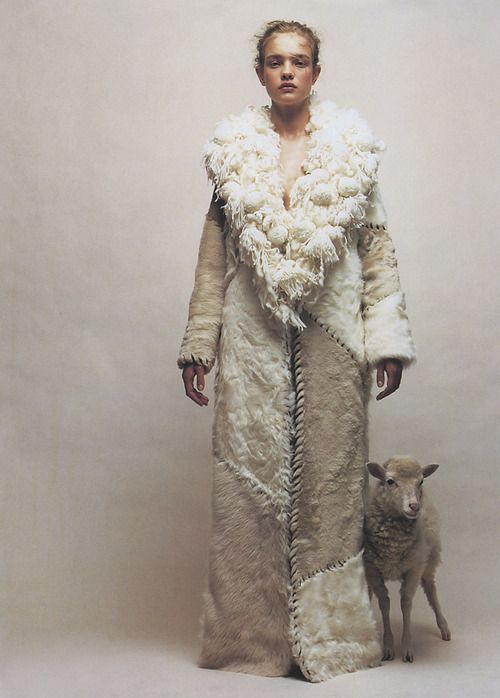
-PETA'southward media department claims in the same article that "Many wildlife used by the entertainment manufacture—including dandy apes, elephants, and large cats— usually live in deplorable conditions in animal-training compounds and are routinely beaten or shocked during grooming sessions. Even the best-known trainers are frequently cited by the U.S. Section of Agriculture for violating the federal Animal Welfare Act, which establishes just minimal guidelines for fauna care."
-It is upwardly to brands and fashion magazines to show the truthful side of the issue. Animals that are proper taken care of should be the only ones existence used, to ensure that companies are not supporting trainers and organisations with malpractices.
-Studies by Stephen Ross with chimpanzees have shown that majority of people thought that these animals were not endangered since they ofttimes appear on commercials. Magazines and brands should notify consumers about the species situation, requite more value to the animal, and not but apply it equally an object.
8. CASE STUDIES
The review continues with the case written report of three brands – Stella McCartney, H&M and Hermès- to understand if brands are willing to make an upstanding change or a sustainable one. If a brand chooses to change ethically, this ways that by no risk fauna materials will be used. In the other manus, if a brand is irresolute due to environmental reasons, this can be a result of the global "green" trends (veganism, organic, fair-trade), and a full abstinence of creature materials may not be necessary.
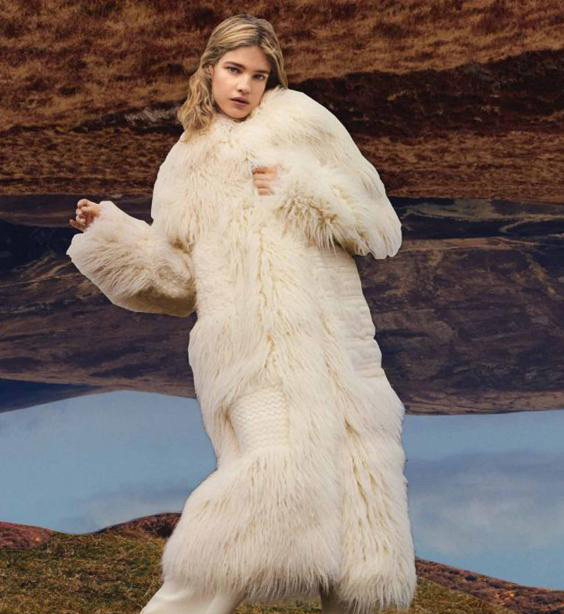
STELLA MCCARTNEY
Founded: United Kingdom, 2001
Segment: Premium
-Stella McCartney is one of the few vegetarian brands inside the luxury universe. The company does non utilize fur, feathers or leather and does not carry any type of animal testing. It is committed to keeping fauna materials usage to the minimum, except for wool and silk.
-It is committed not just to ethics, just also to sustainability, taking into consideration the consequences of the overproduction of animal products.
-In their website they provide data regarding the negative impact that meat and leather product take on the surround, the different toxic chemicals used for the treatment of leather and the risksboth for people and the planet. (McCartney, 2016)
-The development of sustainable alternatives is a complex process. The brand uses materials costless of PVC (well-nigh damaging plastic), usually mixing natural and synthetic fibres. Due to the express evolution of this industry, more than than 50% of a product, needs to be produced manually. (McCartney, 2016)
-The company is aware that both leather and constructed are equal when information technology comes to damaging the planet, simply its delivery to use renewable and natural sources is clear:
–Eco Modify Nappa is an alternative to leather made with vegetable oil, enabling the make to use less petroleum.
-Nigh of the polyester used in Stella McCartney's products come from recycled plastic.
–Bioplastics, based on plants of non-nutrient sources that do not cause "land conversion", are also usually used. (McCartney, 2016)
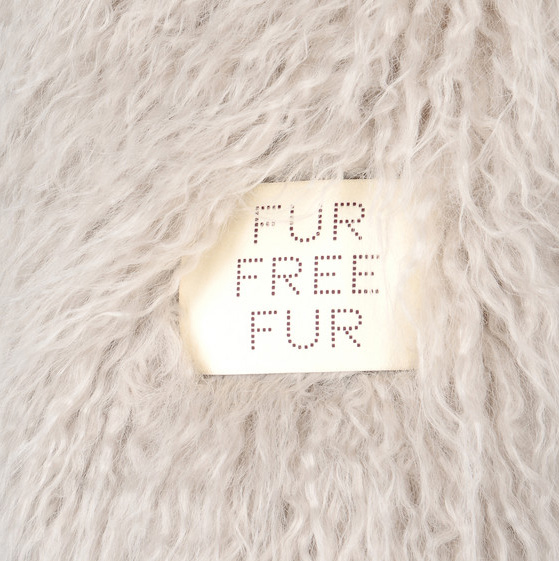

H&Yard
Founded: 1947, Sweden
Segment: Mass Market
-On the official website, H&M explains the partnership with different associations or organisations to accomplish its sustainable goals. In partnership with Textile Exchange, Control union, Humane Society International and other brands, H&One thousand is improving its standards and ensuring traceability on their wool products, sourcing feathers from farms that exercise non practice live-plucking or force-feeding, and using leather only from animals that take been bred for meat consumption.
-H&M as well provides a list of other policies regarding the employ of animate being materials and their welfare:
-The brand does use existent fur in any products.
-H&M prohibited the apply of hair from angora rabbits (a very polemic fabric due to live plucking).
-The wool sourced for H&M does not come up from farms that practice mulesing.
-The company does not sell skins from exotic or endangered species.
-The Conscious Fashion collection uses either organic or recycled animal materials. Both leather and silk are organic and sourced from farms where animals are non fed whatever hormones and have a fair life. The line also includes pieces made from recycled wool.
HERMÈS
Founded: France, 1837
Segment: Luxury
-Hermès is 1 of the leading luxury brands and it is specialised in high-quality accessories.
-Notwithstanding holds a strong connection with its essence and roots: equitation. The horse, an creature that is loved and owned by a certain class of people, gave the possibility for the brand to be adult and abound. (Les Ailes d'Hermès, 2016)
-Although Hermès launched and adult dress collections, the loftier-quality leather products were the key point to brand the brand unique. (The Richest, 2016)
-Since leather craftsmanship is part of Hermès Dna, the apply of unlike types of skins and animal materials is highly prominent for the visitor.
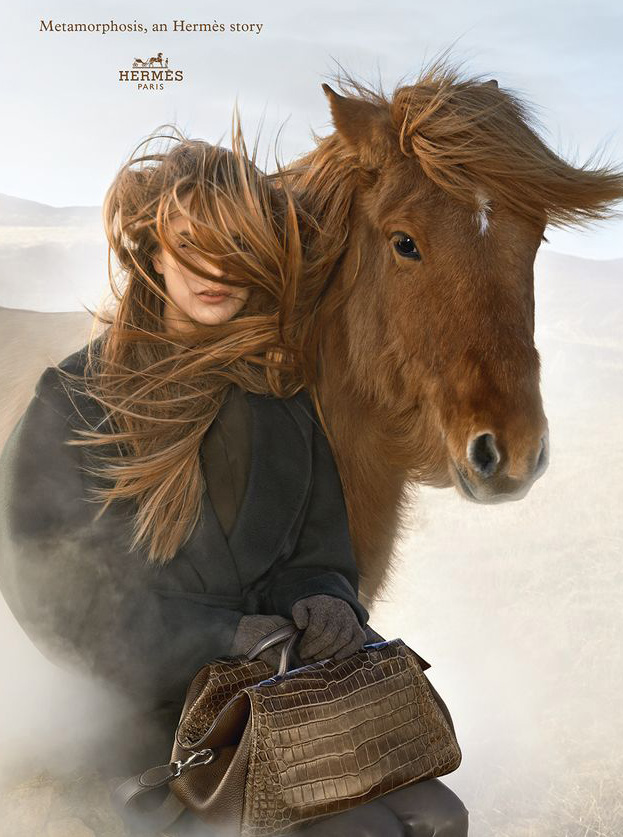
–Provides less data virtually how the materials are sourced and what actions are practised regarding sustainability. A complementary source –a stockist store that sells the products of the brand- volition besides assist in completing the list, but it must be taken into consideration that Hermès does not publicly share a full list of all the materials, and how these are sourced.
Silk (silkworm), calfskin (young calf), mohair (angora goat), cashmere (goats) merino wool (merino sheep), standard wool, crocodile pare (saltwater crocodile and Nile crocodile), goatskin, rabbit, lambskin (young lamb), buffalo horn, alligator pare, horsehair, ostrich peel, young bull leather, mature cow leather, goose feathers, lizard skin (Nile monitor lizard), fur. (Bragmybag, 2014)
In the annual report from 2014, there is a whole affiliate dedicated to sustainability. The brand displays extensive information on how the primary commitment is to reduce h2o waste and free energy, and which sectors of the brand use more resources. The graphic from the make demonstrates that the largest consumption of resources comes from textiles, leather goods and tanning. (HERMÈS 2014 Almanac REPORT, 2015)
But when it comes to explaining what measures are practical to the animals used, the information is deficient. The brand assures that it obeys the intended laws regulating the use of endangered species; and that their sheep and cowhides only come from Europe. No more than information apart from the stated is bachelor.
Hermès also included recently a new project chosen Petit H that aims to reuse of all the storage materials from previous years, to produce new products.
Hermès shows a mismatch between word and deed. The brand old and strong relation with equitation does not connect with the use of animal skins and hair. 1 could argue that the brand always used leather and that the master focus was always on the rider, and not on the horse, but this thought will presently be in conflict with social sensation and the evolution of perspective. This can be seen in the design of the official online store, the image on the right, for case, where cows habiliment earrings made of buffalo horn equally eyes, show the extreme disconnection between the creature and the object.
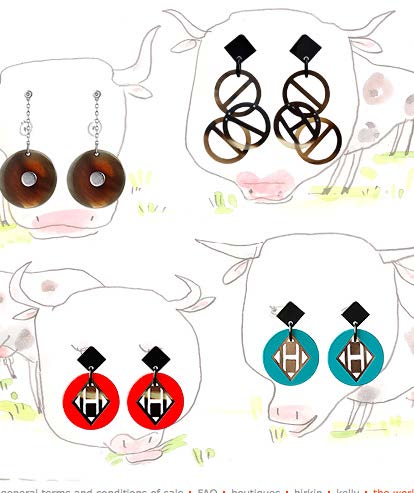
9. THE Market place. DIFFERENCES BETWEEN MASS-MARKET AND LUXURY
Both, mass-market place and luxury brands, heavily utilize animal materials. But is in that location any difference in how they use it? This chapter exposes data to answer this question.
-Regarding production, it is difficult to make a definitive statement. The lack of sources that give proof of which market uses more fauna materials limits the possibilities. Through analysing the largest producers of the cattle herd, it is possible to determine that countries such as Bharat, Brazil and China lead the marketplace. Fast-fashion brands ordinarily source their products on countries where labour is cheaper while luxury brands source their products based on the necessity. Hermès for case, sources their cattle skins from Europe.
-With this small analysis, it is possible to presume that mass-market place brands produce more leather products, since it sources most materials from the countries of higher cattle herd product, and take a wider consumer base of operations to assist, meaning the overproduction of leather. Additionally, luxury brands use a wider multifariousness of animals and play a heavy role in the fur industry.
-When it comes to wool, Mass-market place brands such as H&M and Inditex prohibited the use of wool from angora rabbits and from sheep that go through mulesing. Due to the lack of data about how nigh materials are sourced in the luxury market, information technology is difficult to affirm that luxury brands sourced from ethical farms that ensure creature safety. Angora and cashmere are highly used by this market.
-Both industries use animals every bit i of their main materials. Although mass-market only uses certain animals, the production of fast fashion products is higher. Both markets are unethical and unsustainable as long equally animals are yet incorporated in their products. Fifty-fifty though the number of animals used is lower inside the luxury industry, there is still a chance for them to be quite similar. Considering that luxury brands produce articles that follow high standards, some might crave a higher number of animals, due to patterning or design.
-The main divergence are the types of materials used. Inside the luxury market place, the use of exotic skins such as crocodile and ostrich is something ordinary, while mass-market brands utilise skins that come from animals that are domesticated and slaughtered for food.
-Apart from a small number of luxury brands that abjure from this practice, most companies use fur in products. Inditex, like H&M, do not sell the material and is involved with associations that aim to protect the animals involved and abolish the practise. (Inditex.com, 2016)
–Luxury brands give little information near the employ of animals. Both Prada and Hermès, for example, only mention the utilise of animal materials on annual or social responsibility reports. Mass-market brands manage to provide more detailed and articulate information on the used materials. The information is also easily establish on corporate websites. In improver, luxury brands do non refer to "animal welfare" or any concept of the sort, like mass-market brands. They talk well-nigh "sustainable use of raw materials" or "preserving biodiversity".
-While fast fashion brands try to inform the consumers, luxury brands go along a more neutral position. The information is available for the consumer that it is willing to know and research, yet the lack of involvement with transparency makes the statements regarding an ethical use of animals incredible.
10. WHICH NEW TRENDS ARE APPEARING REGARDING THE USE OF ANIMALS?
Nowadays, nearly people are aware of the vast listing of environmental issues affecting Earth'southward biodiversity and ecosystem. With the rapid access to information, consumers accept more accessibility to know and learn nigh the brands they purchase from. What is the consumer perspective on the utilize of animals?
A report on consumer trends regarding sustainability shows specific data about what consumers are looking for in brands and how they are dealing with sustainability. This information applies to all products and sectors: (SolarCity and Clean-Border, 2013)
- 72% of consumers want to learn more than well-nigh corporate sustainability initiatives.
- 75% of consumers would exist more probable to buy a product or service if the company is making an effort to be sustainable.
- 82% of consumers are more than likely to buy a production that represents Corporate Social Responsibility than i that does not.
- The bulk of consumers have a strong interest in sustainability and "green" products and desire more than data.
- The bulk of consumers point they're unwilling to pay more than for greenish.
- Given a choice betwixt greenish and non-green products of similar quality, consumers choose green past a large margin.
- The younger generation is showing even stronger green consumption trends.
- There is strong involvement by consumers in green products simply as well strong scepticism.
- Consumer activeness is unpredictable. Attitudes don't always translate into purchase decisions when it comes to greenish products and services.
- There are large information and sensation gaps with regard to new applied science and products.
- Social media and online reviews are creating a heightened level of brand transparency, an opportunity for reward or punishment from consumers.
Is possible to see a alter in consumer behaviour when it comes to the utilise of animals every bit well. For example, in the Labour Backside the Label website, a printing release titled Eu citizens need transparent and off-white production of shoes and leather explains that European consumers "want more transparency in the supply chains of shoe and leather industries, strict criteria for incoming appurtenances and amend data provided by labels on our shoes" (Labour Backside the Characterization, 2016)
-This new approach can have a huge influence. If the need is a transparent approach, brands might need to be truthful regarding the real impact that the production of leather has in its employees and surroundings. This could pb to different scenarios: from the demand of leather appurtenances dropping to the sectional use of brands that are really sustainable and ethical. Brands need to adapt to the situation.
-In the U.One thousand. over a period of x years, the number of vegans has increased more 360%, around half-million people (Quinn, 2016).
-Sure brands are reacting. The most recent and popular situation was with Armani, that just recently quit fur in all its fashion clothing and accessories lines. The make explained that the pressure of animal activist groups and the increase of social and sustainable responsibility helped in taking the decision. (the Guardian, 2016)
-The pressure from fauna rights activists and organizations is growing and with a deeper and more than intelligent strategy. The animal rights organisation, PETA, has recently purchased shares from both Hermès and Prada, in lodge to accept admission to almanac meetings. (The Fashion Police, 2016). Information technology volition give the opportunity for animals to accept a voice inside the brand, and influence a more ethical behaviour. (Wahba, 2015)
-The research of alternative and sustainable materials that have similar properties as the animal version is a growing trend, both for consumers and brands. For instance, leather made from tea is a new sustainable possibility. Fake fur, for case, is less sustainable than real fur, only if the fake fabric is from natural or reusable materials, it has more value. This specific marketplace still needs to be highly explored and developed, but if the need grows, an increase of substitutes for creature materials is possible.
11. WHAT IS THE CONSUMER ATTITTUDE TOWARDS THE Utilise OF ANIMALS?
The demand for fashion products fabricated from brute materials increases annually. Not just leather and wool, but other materials, such as fur, have been performing positively into the market.
In the example of fur, for example, at that place are dissimilar factors that influenced the increment in need. The anti-fur motion lost its credibility from the moment its vocal leaders started to wear fur over again, such as supermodel Naomi Campbell. Other celebrities and role models to the consumer (millennial generation) such as Kate Moss, Rihanna, Cara Delevingne also article of clothing fur. Not only celebrities influenced consumers to have fur again, but it also became more available (Licata, 2014). In 2014, 70% of designers used fur on their runway shows. (Fisher, 2014)
A study conducted past YouGov also revealed that merely 58% consumers between the ages of 18 and 24 years believe that wearing and buying fur is wrong. Fur companies accept likewise been sponsoring competitions for style students, by supplying all the materials required (Licata, 2014).
In certain situations, consumers discover a lack of transparency and labelling regulations from brands. Kit and Ace had recently a scandal with the use of fur from raccoon dog (animal from canine family). The make responded by denying all the accusations (CBC News, 2015). Customers were unsatisfied:
Consumer 1: "I will support a #Boycott until your fashions are animal fur free. The activist customs will also spread the word far and wide. Please do the right affair."
Consumer 2: "Whether or non the raccoon dog is a raccoon (which information technology is not) or a canine (which it is) is beside the point. A quick google search will prove videos of these animals being skinned alive in Red china. I don't believe for a second you ethically source your products." (McSheffrey, 2015)
INTERVIEWS
To support this research, Bárbara Ferreira conducted 7 interviews with different fashion consumers between the ages of 20 and 25 years onetime.
In order to have a wider perspective, two different interviews were equallysembled, the showtime for interviewees that wear and support a lifestyle that uses animals or people that follow a lifestyle that ensures minimal beast suffering and the second for interviewees that follow or try to follow a vegetarian or vegan lifestyle. Both interviews include eighteen questions that focus on themes such general ownership behaviour, lifestyle and choices or sensation about the industry. Below yous can read a summary of some of these questions.
Buying PATTERNS
-Some consumers get shopping from one to 3 times every month.
-Others buy less, usually every 2 months or during sales seasons not having a specific buying pattern.
-The residual are not impulsive when ownership, and strictly do it when in need of a certain detail.
Sensation OF THE Carry OF THE BRANDS THEY PURCHASE FROM
-Most consumers were unable to requite a physical answer.
-The two consumers that follow a vegan and vegetarian lifestyle are not truly aware of the brands that they purchase from, only having a general thought most a specific topic, such equally child labour or low wages. Interviewee Filipa complained well-nigh the lack of transparency from brands, and the lack of information bachelor, which difficult the process.
-2 other consumers admit that they have a general idea about the way manufacture, simply that they cannot speak for private or specific brands.
-The last group of interviewees consider themselves enlightened of brand'south deportment, due to social or professional reasons and are enlightened of the unethical conditions and pollution production.
LIFESTYLE AND Electric current RELATION WITH ANIMAL PRODUCTS
-Four interviewees follow or try to follow a greenish trend. Two consumers follow a vegetarian and vegan lifestyle, for ethical, environmental and personal reasons.
–Andrea follows a vegan lifestyle. "There should be a way where people explain veganism in a more than in-depth way because I think right now people don't take it seriously, they make fun of it… Is for the improve not for worse, then I don't know why they make fun of it.".
Despite the fact that some interviewees follow a vegetarian or vegan lifestyle, they all the same own products that are fabricated from animals and wear them occasionally. The only consumer that abstains the possibility of e'er ownership animal products again is Filipa.
–Joana and Andrea country that although they try to avoid it, they oasis't fully commit to this lifestyle. They tend to purchase creature-free products, but make exceptions when it is a very desired product or for a "special occasion".
The residuum of interviewees land that they do not follow any of this greens trends and state that they all vesture animal products, having a preference for leather, and using fur or wool more occasionally. In conclusion, all of the interviewees own leather accessories (shoes and bags) and about of them as well own fur or leather outerwear (coats, jackets and vests). Wool is as well constitute in interviewees' sweaters and jackets.
Natalia: "(…) I'm not a follower of whatsoever of these trends. (…) Because for example H&M sells organic cotton products, but information technology's incoherent, as producing one,000 tons of organic cotton fiber products is likewise contaminating (…) and they are non providing good working conditions even though they say so. Likewise, Whole Foods sells "organic" and "fair merchandise" products and recently an article came out proving that their products are non organic and so on. Therefore, I think that these trends are kind of a "lie" and marketing strategies (…), because in the world nosotros live on now, unfortunately, it is impossible to be 100% sustainable as there are billions of people and then product needs to exist in mass, making it inevitable to contaminate or affect the ecosystem."
SPECIFIC QUESTIONS FOR CONSUMERS THAT Abstain ANIMAL PRODUCTS
Since both interviewees mostly eat fast fashion brands, they do own article of clothing and accessories that are fabricated without animal products. The materials that the interviewees are enlightened of are linen, polyester, and cotton wool, and practice non have any preference.
AWARENESS OF THE PRODUCTION OF MAN-MADE OR VEGETAL MATERIALS
Seems depression. Filipa: "I really take no idea how the things are sourced or manufactured. I don't think I have a clue. I could try to say something, but I'one thousand very misinformed most this. (…) companies are not transparent about it."
This lack of cognition also applies to sustainability. Both consumers were unable to affirm that they accept knowledge about the ecology impact of man-made materials.
SUSTAINABILITY OF THE CURRENT USE OF ANIMALS Within THE INDUSTRY
Both consumers hope that the fashion manufacture takes measures in the future and reduces the employ of animals. Filipa: "(…) this industrialization needs to be rethought for the hereafter, for certain, considering the generation now is completely different. (…) And it volition change. People want to know what they are eating, what's behind the mode industry, all the products that they buy. They want to come across transparency in companies and maybe it's just me, but I see it equally a generational problem. I hope that this volition happen."
A MESSAGE TO PEOPLE THAT Withal Consume ANIMAL PRODUCTS
Filipa: "I would say, merely stop using that fur, it looks stupid. Simply it's like, merely think most information technology when you buy something. Go watch the video near People's republic of bangladesh, go lookout a video on YouTube, try to educate yourself, and then, afterwards you lot encounter those things, get do your shopping."
Joana: "Don't eat animals. Reduce your shopping, and buy simulated leather next fourth dimension. Research about what is happening, considering nosotros all need to go on informed."
SPECIFIC QUESTIONS FOR CONSUMERS THAT USE Animal PRODUCTS
FEELINGS THEY HAVE WHEN WEARING ANIMAL PRODUCTS
-João feels fierce, powerful, warm and fabled.
-Natalia feels a sense of exclusivity, when wearing materials such as fur or crocodile.
-Ricardo demonstrated a neutral position: "At that place are no feelings that I can mayhap have while wearing these products. I tin can't feel an animal through a material, and I don't even think near information technology when I get dressed. If our consciousness were admittedly analytic, information technology would be impossible to exist in the world."
INFLUENCES Backside THE Utilise OF THESE MATERIALS
All interviewees generally disagree that animal products are ethical, but at that place is still a belief that civilization and history can justify these practices. Since humans have been using such materials for thousands of years, and civilization and beliefs tin be difficult to change.
AWARENESS OF THE PROCESS BEHIND OF ANIMAL PRODUCTS
3 consumers demonstrate a general sensation. Natalia: "Aye, I know the process is actually mean and shocking and the animal suffers a lot as I've seen videos where people ripped off the skin from the brute while they are live and then leave them skinless on the floor to decease. But it is something I try to avoid on my heed."
Interviewees think that the apply of leather is ethical, considering information technology is a by-production of the meat manufacture. The expiry of the animal, or wearing the product are not the main consequence, simply the poor weather condition for animals and unstainable ways of production.
When information technology comes to the use of endangered species, nearly consumers are non fully enlightened of how the industry works and don't fully support this practise. Consumers believe that the animals in question should exist preserve and protected.
Consumers don't hold that the use of the animals is sustainable. Ricardo: " The consumption is undue, is too big, the industry follows wrong conducts and ideas. (…) fifty-fifty sustainability is involved in the propaganda of capitalism'southward web and corrosive reality".
–Greta: "Some players are trying to embrace the concept of sustainability, however (…) sustainability should exist incorporated into the core of businesses and their managements, as all processes and activities should follow the same vision of accomplishing a sustainable bear upon (…)."
REACTIONS TO THE VIDEO
The consumers are asked to watch a video produced by VICE titled Toxic Tanneries Poisoning Workers in Bangladesh, and requite their opinion. The video explores the damaging effects that tanneries accept in India, and in the communities involved.
Natalia – "Watching this video made me realize the horror that is happening in the fashion industry. (…) I don't call back that the use of animals is something extremely bad, the negative aspect of it is the conditions in which such products are made. (…) It is horrible to recollect that brands cannot increment maybe a 10% of their budgets to provide employees with proper weather, the proper compatible to protect their skin and their health, and the proper medical treatment for them not to get intoxicated. (…) What I'm trying to say here is that (…) if they are willing to practise and then, they tin."
Filipa – "I was completely shocked because I had no idea how Bangladesh actually looked like. This information should be in front end of everyone's eyes earlier they buy leather. Well, I recall brands could have action because it is hard to believe that this is the just way of making a profitable product."
Greta – "After watching this video I truly feel some kind guilt for purchasing beast-related products, however, I fell even worse when thinking about the horrible conditions that all those people are living in, specially while risking their health and lives to only survive. The fact is that, every bit consumers, most of the fourth dimensionwe are not aware of the procedure behind the production. If we were, we would be more conscious of our purchasing decisions."
Ricardo – "This situation is absolutely catastrophic and centre-breaking. I'k absolutely aware and witting of this reality that makes me experience shameful and wish it has never happened. For me, it is absolutely absurd, and humanity keeps a hypocrite position, destroying itself and the planet. Even though I can't change the globe, for me is still essential to be conscious of reality and to contribute with what I can".
Joana – "This is terrible and sad. This is why the industry needs to reduce its production and balance it. Producing so much merely in one place destroys the state and the people. I hope more people come across this video. I hope the manufacture takes measures quickly."
Andrea – "People think that they are only going to help animals. That'south why many people say "I eat meat, why don't wear animals", just I think information technology is because they don't see that is not merely amercement the animals, just information technology damages the employees, the people. And if they knew more than most this, because making this kind of products involves a lot of chemicals, I think it would be a mode of making the style manufacture more than sustainable. Making this known to the world, because people are dying considering of this."
João – "It's ridiculous, this process and this new form of slavery. Those acts need to end."

AUTHOR
Barbara Ferreira (Portugal, 1994) graduated from Way Marketing and Communication (BA) in 2016.
Source: https://management.iedbarcelona.org/portfolio/animals/
Posted by: andradefacces38.blogspot.com

0 Response to "What Do Animals Think When We Change Clothes"
Post a Comment